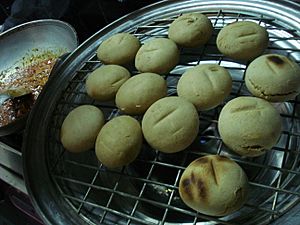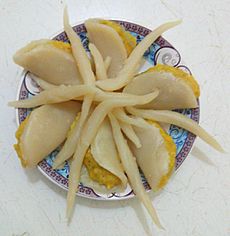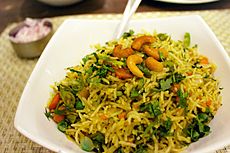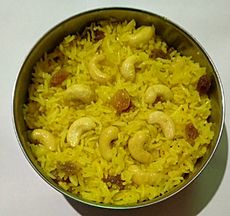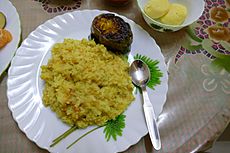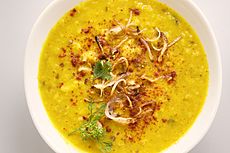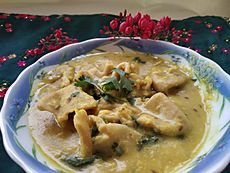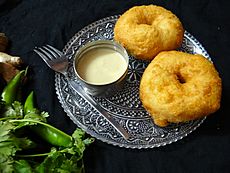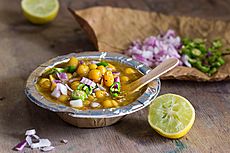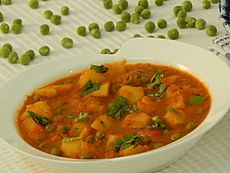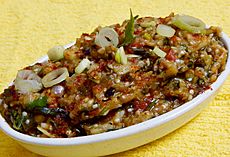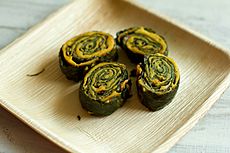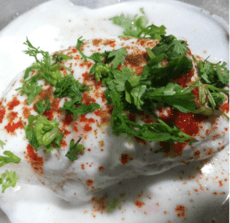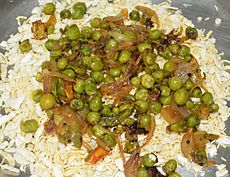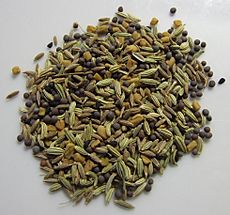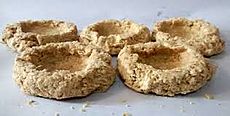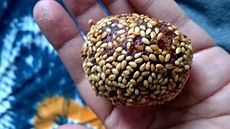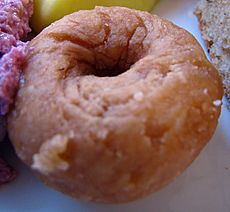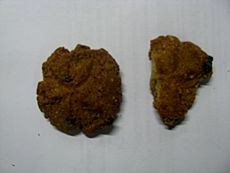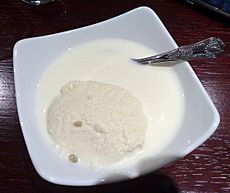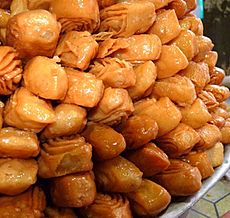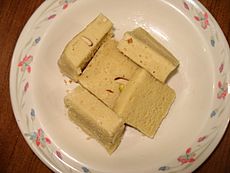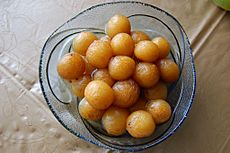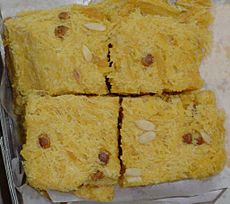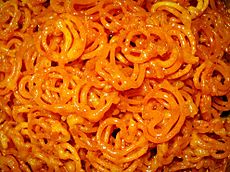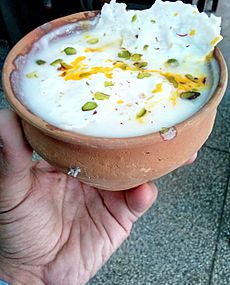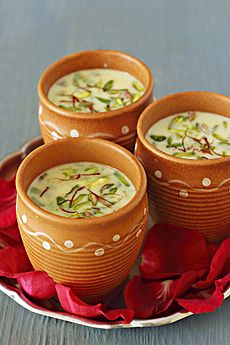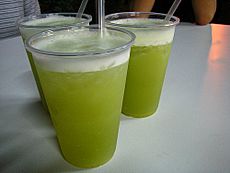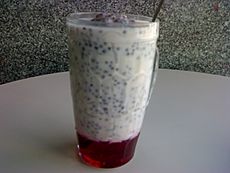Bhojpuri cuisine facts for kids
Bhojpuri cuisine is a special way of cooking food. It is popular among the Bhojpuri people who live in Bihar and eastern Uttar Pradesh in India. Bhojpuri dishes are usually mild and not too spicy. But you can make them hotter if you like!
Bhojpuri people enjoy eating both vegetable and meat dishes.
Contents
Breads
Many different kinds of breads are eaten in Bhojpuri cooking. Roti or chapati is made almost every day. People eat it with all their meals. Sometimes, breads made from millet are also cooked, depending on the season.
Paranthas are often made for breakfast. In some areas, they are called paravaathas. These flatbreads are usually filled with vegetables, chhena (a type of cheese), dal (lentils), or sattu (roasted gram flour). Sometimes, layered paranthas with spices like ajwain (carom seeds) are also prepared.
On special days, deep-fried breads like puri, luchui, suhari, and kachori are made. Sweet pancakes called Puas are also common. They are often cooked during the monsoon season or for religious events.
Here are some special breads unique to the Bhojpuri region:
- Makuni/berhai: This is a puffed wheat bread. It is filled with sattu and spices, then fried.
- Litti: Litti is a hard, round wheat bread. It is usually eaten with chokha, which is mashed vegetables. There are different types of litti. Phutehri is a litti filled with sattu and spices.
- Gojha/pangojha/bhakosa: This bread is stuffed with dal. It can be cooked by steaming or frying. The dough can be made from wheat flour, rice flour, or semolina.
- Dohathi/panhathi: This is a soft, thin, and double-layered roti.
- Chautha: A thin batter is spread on a hot pan, like a dosa or cheela.
- Dahirvari: These are sweet, fermented fritters. They are often made in large amounts to give to married daughters. Flour is mixed with jaggery water and left to ferment. Then, the batter is shaped into balls and fried in ghee.
- Mahuari: This bread has a special flavor from the mahua flower.
- Dhuska is made by frying a batter of rice and lentil flour. It is served with aloo ghugni (potato and pea curry) or chhole (chickpea curry) for breakfast.
- Thekua: This is a sweet snack or dessert. It is usually prepared during the Chhath Puja festival.
For special events, breads like tandoori roti, stuffed naan, and rumali roti are also prepared.
Rice Dishes
Rice is a very important food in the Bhojpur region. Plain boiled rice is eaten almost every day with lentil soups, bean gravies, and curries. Besides plain rice, other common rice dishes include:
Noon Jaauri: Rice is cooked with salt and spices. Vegetables like green peas, carrots, cauliflower, and lentils are sometimes added. It is served with Raita.
Meethi Jaauri: This is sweet rice cooked with jaggery or sugar. Dry fruits and saffron are added for extra flavor.
Dahi Jaauri: Partially cooked rice is mixed with yogurt. Spices are added to make it taste even better.
Doodh Jauri: Rice is cooked in milk with ghee, dry fruits, sugar, and spices like cardamom. This dish is similar to Kheer, but it is usually thicker.
Khichdi: This dish is often eaten when someone is recovering from illness. It is also prepared for festivals like Makar Sankranti. Khichdi is usually eaten with pickle, chutney, pappad, and yogurt. Khatua, a type of Khichdi, is flavored with lemon juice.
Lentils and Pulses
Dals: Lentils are mostly cooked as soups and eaten with rice and rotis. Many types of lentils are used in Bhojpuri cooking. These include Arhar (pigeon pea), Chana (split chickpea), moong (mung bean), matar (yellow peas), and urad dal (black gram). Arhar dal is the most common. It is often flavored with dry mango, panchphoran (a five-spice mix), and jaggery.
Dal Pitthi/Pithori: Small wheat dumplings are made and cooked with Dal. This makes the Dal thick. Dal Pitthi/Pithori is a complete meal, like Dal Roti or Dal Bhaat.
Phulvara (Pholourie): These are fritters made from Urad flour. Spices like black pepper and asafoetida are added to the batter. Small balls of batter are fried in hot oil. A hole is made in the center of each fritter. They are served with chutney or dipped in yogurt.
Peas and Beans
Ghughni: This is a curry made from soaked and boiled peas or chickpeas. Different versions use black gram, green peas, or white peas.
Nimona: This is a spicy curry made by mashing peas or beans. Sometimes, vegetables are also added. Matar ka Nimona (pea nimona) is the most common type. It is a popular winter dish.
Vegetable Dishes
There are four main types of vegetable preparations:
1. Bhujiya (Stir-fried vegetables): Chopped vegetables are stir-fried in oil with spices.
2. Rasiya/Rassewali Bhaaji or Jhol (Vegetables with gravy): Vegetables are cooked with a soup or gravy. For example, Aloo Rassewale or Aloo Jhol (potato curry with gravy). Sometimes, peas or chhena pieces are added.
3. Bhariya/Kalauji (Stuffed vegetables): Vegetables like Karela (bitter gourd), Baingan (eggplant), Parwal, Bhindi (okra), and capsicum are filled with a special spice mix and then cooked.
4. Chokha (Mashed vegetables): Vegetables like eggplants, tomatoes, and tubers are roasted or barbecued. Then, they are mashed and cooked with spices.
Leafy Vegetable Dishes
Saag: This refers to dishes made from leafy green vegetables. Leaves from various plants are used for Saag, including Channa, Bathua, Methi, Palak, and Sarson. Channe ka Saag (chickpea greens) is the most common. It is often mixed with Bathua leaves for better flavor. Sometimes, potatoes and chhena (cottage cheese) are added to Saag.
Girvanchh/Rikvanchh: Leaves of Arua (colocasia) are covered with a batter of besan (chickpea flour) and spices. The coated leaves are folded and deep-fried like fritters. They are often eaten during the monsoon season.
Sakauda/Saheena: Sakaudas are round fritters made from leafy vegetables like spinach. These can be eaten as they are, or used to make Chaat (a savory snack) or Curry. Sakauda Chaat is a popular street food. In homes, Sakauda Kadhi (a yogurt-based curry) is often prepared.
Yogurt-Based Dishes
Kadhi Badi: This is a yogurt-based curry cooked with gram flour. Fried fritters called Badi are added to it. It is eaten with rice.
Dahi Phulvari (Dahi Bada): Lentil flour fritters called phulvaris are made and soaked in flavored yogurt. This dish is often cooked during weddings and special family events.
Dahi Phulki: Small, crispy puris (fried bread) are soaked in flavored yogurt.
Dahi Chura: Yogurt is mixed with flattened rice and eaten with some jaggery.
Raitas: These are made by mixing mashed vegetables with flavored yogurt. Some vegetables used for Raita are Lauki (bottle gourd), Kakkdi (cucumber), and onion. Sometimes, Boondis (small fried gram flour balls) are added to make Boondi Raita. Sweet Raita can also be made with bananas.
Main Foods
Wheat and Rice are the main cereals for most people. Maize, Barley, and Pearl Millet are also widely eaten in Bhojpuri cuisine.
Lentils (daal), beans (lobiya, rajma), meat (like mutton, lamb, and chicken), green vegetables (Tarkari), leafy vegetables (saag), paneer (Indian cheese), and fish are important parts of the daily diet.
Breakfast
A big breakfast or brunch is traditionally called Kalewa. A lighter breakfast is called Jalpaan. Breakfast in this region often includes different breads made from wheat flour. These can be roti, puri, or parathas. Popular parathas include Sattu Paranthas, Chhena Paranthas, and vegetable-stuffed parathas. They are served with Saag-Bhaaji (leafy greens and vegetables), dahi (yogurt), or raita. Breakfast often comes with yogurt drinks like Mattha, Chhachh, and Banarasi Lassi.
Makuni or Berahi: This is a wheat bread stuffed with sattu. It is usually eaten for brunch.
Dhuska with Aloo Chhole or Aloo Ghugni: Dhuska is a fried bread made from fermented rice and lentil batter. It is served with chickpea dishes like Aloo Ghugni or Aloo Chhole.
Chana Chabeni or Bhuja/Bhunjna is another typical breakfast. This dish is often prepared on a large outdoor stove.
Chiura Matar or Matar Ka Bhuja: This is a popular winter breakfast. It is made by frying Chiura (flattened rice) and Matar (peas) separately, then mixing them.
Dahi Chura with Gud: Flattened rice is eaten with thick yogurt and topped with some Gud (jaggery). It is especially made on Makar Sankranti day.
For special occasions, breakfasts might include Lapsi-Puri, Kheer/Sevai-Puri, Pua-Dahi, Chhola-Puri, and more. Common street food breakfasts include Puri-Bhaaji, Chana, Kachori, and Jalebi.
Lunch
Lunch usually features rice. It includes Dal (lentils cooked with spices), sabzi-korma (vegetables or meat in a rich gravy), chokha (mashed vegetables), chutney (like coriander chutney), bhujia (pan-fried potatoes), and pickle. Some people also eat rotis with their lunch. On special occasions, lunch can change a lot. It might include rice dishes like pulao and biryani, along with many other delicious dishes, sweets, and savory items.
Snacks
Snacks are usually served with tea in the evening. They include many kinds of fried and salted treats. Sometimes, people eat a generous amount of dry fruits instead of snacks. These include raisins, almonds, dates, peanuts, walnuts, cashews, pistachios, and dried figs, often soaked in milk.
Dinner
Dinner is also often roti-based and eaten with different vegetable dishes:
- Bhujiya: Bhujiya means stir-fried vegetables. These are usually dry dishes cooked without gravy. Examples include Parore Aloo Ki Bhujia and Bhindi Aloo ki Bhujiya.
- Rasili Bhaaji: These are wet vegetable dishes with gravy or soup. Examples include Aloo Gobhi ki Rasili Bhaaji and Kathal ki Rasili Bhaaji.
Sometimes, roti is broken into a bowl of hot milk (which can be sweetened) and eaten. This is called doodh-roti. Sometimes, litti is grilled over charcoal or baked in a clay oven. It is eaten with chokha or murga (chicken korma). Dinner can also change for special occasions. It might include meat dishes like korma (meat with gravy), kebab, and kofta (meatballs with spicy gravy). These are served with tandoori roti or naan and salad.
Satvik Khana
In the holy city of Banaras, there is a tradition of eating Satvik Khana. This is a Lacto Vegetarian diet. It does not use garlic or onion.
Non-Vegetarian Food
People in this region have eaten non-vegetarian food for a long time, along with vegetarian diets. Non-vegetarian dishes are seen as special treats. It is a custom to serve guests a non-vegetarian dish at least once during their visit.
After the British arrived, poultry became popular. Now, chicken is a major source of meat. However, mutton (goat meat) is still considered superior to chicken and fish.
Fish has also been popular for a long time because many rivers flow through the region. Freshwater fish and small freshwater prawns are also eaten a lot.
Cooking Essentials
Spices and Condiments
Bhojpuri cooking uses only a few spices, sometimes just two or three. This gives the dishes a perfect smell and taste, instead of making them too spicy.
Panch-phoran: This is a mix of five spices commonly used in Bhojpuri cuisine. The five spices are Jeera (cumin), Radhuni (a strong spice), Methi-dana (dry fenugreek seeds), Saunph (fennel seeds), and Kalaunji (nigella seeds). This spice mix is key to dishes like Panch-phoran Kohra (a sweet and spicy pumpkin curry).
Other spices used include:
- Cumin seed (Jeera)
- Caraway seed (Shahi Jeera)
- Cinnamon (Darchini)
- Aniseed (Saunf)
- Black pepper (Kaali Mirch)
- Asafoetida (Heeng)
- Garam masala
- Red Chili (Lal or Laal Mirch)
- Green Chili (Hari Mirch)
- Cardamom (Elaichi)
- Black cardamom (Badi Elaichi)
- Nutmeg (Jaifal)
- Mace (Javitri)
- Saffron (Kesat)
- Flax seed (Tisi/Alsi)
- Dried Pomegranate (Daadim)
- Carom seed (Ajwain)
- Fenugreek seed (Methi)
- Dried Fenugreek leaves (Kasuri Methi)
- Onion seed (Mangraila)
- Mango powder (Amchoor)
- Dried Mango (Khatai)
- Coriander (Dhania)
- Rose water (Gulab Jal)
- Turmeric (Hardi)
- Salt (Noon)
- Black Salt (Kala Noon)
- Rock Salt (Sendha Noon)
- Poppy seed (Khas Khas)
- Clove (Lavang)
- Mustard (Sarson)
- Bay leaf (Tejpaat)
- Sesame seed (Til)
- Nigella seed (Kalaunji)
Herbs, Oils, and Nuts
- Green Coriander leaves (Hara Dhania patta)
- Mint leaves (Pudina patta)
- Ginger (Adarakh)
- Dried Ginger (Sonth)
- Garlic (Lahsun)
- Onion (Pyaz)
- Fenugreek leaves (Methi ke patta)
- Tamarind (Imli)
- Date (Khajur)
- Lime (Limu)
- Lemon (Nimbu)
- Mustard Oil (Sarson ke tel)
- Ghee (Ghee)
- Butter (Maakhan)
- Almond (Badam)
- Peanut (Zameeni badam/ Chinia badam/ Moongphali)
- Walnut (Akharot)
- Cashewnut (Kaju)
- Dried Fig (Anjeer)
- Dried Apricot (Zardalu)
- Pistachios (Pista)
- Raisin (Kishmis)
- Black Raisin (Sultana)
Festival Delicacies
In the Bhojpuri region, festivals are celebrated by preparing many delicious dishes. These dishes are shared with everyone, no matter their religion or background.
Khichdi/Sekraat (Makar Sankranti)
This is the first festival of the year. In the morning, people eat Til ke laddu, Tilwa, Tilkut, and Laai (sweets made from sesame seeds). For lunch, they eat Chura-Dahi-Gud (flattened rice with yogurt and jaggery). In the evening, special Khichdi is served with melted ghee, Pickle, papar, chokha, chutney, and dahi.
Vasant Panchmi
This festival marks the end of winter and the start of spring. On this day, Lapsi (a sweet dish made from semolina) is prepared and eaten with Puri.
Holi/Hori/Paguwa
Holi is a very big festival in the Bhojpuri region. On this day, meat dishes and special sweets are the main attractions. In large families, a goat is sometimes prepared for the festival. Parts of the meat are used to make Bihari Seekh Kebab or pan-fried liver. The rest of the meat is cooked as korma. This korma is eaten with Pua (a sweet, deep-fried pancake). Meat dishes are enjoyed all day and shared with neighbors and relatives. A very sweet halwa made from dry fruits and condensed milk is also prepared.
In the evening, people enjoy delicious Pakora, Gulab jamun, Chhole, Dahi-baras, and Kadhi-bari served with boiled rice.
Shivraatri
On this day, people, especially women, who are fasting eat Phalahar (a diet of fruits).
This is another major festival. The night before, women cook Kheer, Puri, Dal-Puri, and gulgula (sweet fritters). The next morning, after praying, these dishes are eaten as offerings throughout the day.
Sattuani/Sattua Sankranti
This festival falls on a specific day in spring. A special Sattuani Thaali is prepared. It includes cooling foods like Sattu Ka Panna (a drink made from sattu), Aam ka Tikora (raw mango dish), cucumber with roasted cumin powder and rock salt, and Alsi ki Chutney (flaxseed chutney). A cup of Jirwani (buttermilk) also comes with the meal.
Janmashtami
This festival is linked with special Laapsi made from water chestnuts and poppy seeds.
Hartalika Teej
The day before this festival, women spend time preparing Perukia. On the festival day, they offer this dessert and fruits to God. After praying, it is eaten as an offering. It can be kept for several days without refrigeration.
Satvik khana (food without onion and garlic) is eaten for all nine days of Puja. On the tenth day, Dussehra, special dishes like Puri, Kachori, Dum-Aloo, Chhole, Jalebi Pua, Bari-Kadhi, and Dahi-Bara are cooked. In the evening, after a traditional event, there is a custom of eating meat.
Diwali
This is one of the biggest festivals. People enjoy many kinds of sweets and savory snacks, like gujia, anarsa, and ladoo. A sweet always linked with Diwali is Cheeni ke Khilone (sugar toys).
Chhath Puja
This is the largest festival in the region, celebrated for four days. On the first day, "Nahay Khay," after a holy bath, boiled small-grain rice is eaten with lauki ki sabzi (bottle gourd cooked in ghee) and Chane ki dal (chickpea lentils). On the second day, "Kharna," people take a dip in the holy Ganges river. They bring water home to cook Rasiyaao (a sweet rice dish) and Roti. This is eaten as Prasad (a blessed offering) at night. The next day, on "Dala Chhath," Thekua, Kasar, Belgrami, Poori, and other items are prepared by women who are fasting. After two special prayers, on the fourth day, these sweets, fruits, and dry fruits are served as Prasad. They are eaten for several days.
Popular Dishes
Some popular dishes in Bhojpuri cuisine include:
- Channa and Chhole (chickpeas cooked in spicy gravy)
- Rajma (red kidney beans in a mild, creamy gravy)
- Lobiya (black eyed beans in a lightly spicy gravy)
- Dal makhani
- Dal maharani
- Dum Aloo (potatoes cooked in spicy gravy using a special Benarasi Dum technique)
- Pitha (dumplings)
- Urad ka daal (black gram lentils)
- Chokha (roasted and mashed tomatoes, eggplant, or potatoes mixed with garlic, chili, and mustard oil)
- Raita (yogurt dips)
- Kofta (meat, vegetable, or paneer balls in spicy gravy)
- Maakuni (Paratha stuffed with cooked potatoes, peas, or sattu)
- Aloo mutter (potato and pea curry)
- Kadhi-Bari (fried chickpea flour dumplings in spicy yogurt curry)
- Mutton Biryani (long grain basmati rice cooked with mutton or chicken)
- Bihari kebab (meat pieces marinated and grilled on skewers)
- Gulab jamun (sweet fried milk solids balls)
- Pua (sweetened wheat flour batter with nuts and raisins, deep-fried)
- Petha (a sweet candy made from ash gourd)
- Murabba (pickled fruits)
- Mardua and Thekua (fried wheat flour biscuits flavored with aniseed)
- Anarsa (a sweet pastry)
- Dalpoori (puri stuffed with boiled and mashed lentils)
- litti chokha (Litti bread stuffed with sattu, served with chokha)
- Nimona (made of green peas)
- Ghugni (pan-fried and seasoned green peas or black gram)
- Dahi chooda (Curd and flattened rice)
- Daal pithouri (wheat flour dumplings cooked with dal)
- Gojha (stuffed with dal and steamed)
- Gujhiya (sweet dumplings)
- Mal Pua (sweet pancakes)
- Padukiya
- Laktho
- bharwa (stuffed vegetables)
- Nimki (savory fried snacks)
- Kachauri (fried pastry)
- Sev (crispy noodles)
- Dalmot (savory snack mix)
- Chana ke saag (chickpea greens)
- Sarson ke saag (mustard greens)
- Bathua ke saag (chenopodium greens)
- Palak saag (spinach)
- Khesari ke saag (grass pea greens)
Desserts
- Gaja
- Rasmalai
- Khajhulee
- Meethe Samose (sweet samosas)
- Batasha
- Halwa, often made from semolina, carrot, chickpea flour, or whole wheat flour.
- Sohan halwa
- Laddoo (sweet balls made from various flours or nuts)
- Barfi
- Murabba (sweet preserves)
- Petha
- Kheer (rice pudding)
- Sheer Korma
- Sevai (vermicelli)
- Kalakand
- Pera
- Son Papdi
- Methi Ke Laddoo (especially in winters, made with fenugreek seeds, flax seeds, ghee, jaggery, and nuts)
- Tilwa (especially in winters)
- Til ki Laai
- Tilkut
- Parwal ki Mithai (sweet made from pointed gourd)
- Jalebi
- Belgrami (a dry sweet made from refined flour, sugar, and ghee)
- Pedukia/Murki (a dry sweet stuffed with a mixture of milk solids and sugar, then fried)
- Ghujhia (Pedukia dipped in sugar syrup)
- Laktho (a dry and hard sweet made from refined flour and jaggery)
- Malai Kofta (sweet version)
- Pua
- Malpua
- Sev-Bunia (Bundia)
- Kulfi
Drinks
- Banarasi Lassi: Varanasi, a famous city in the Bhojpur region, is known for its special Lassi. This Banarasi Lassi is made with thick, creamy yogurt. It is sweetened, churned, and served with a generous dollop of Rabdi (thickened sweet milk) in clay cups called Kulhads.
- Amjhora: This is a Mango-based drink made in summer. Raw mango is roasted, peeled, and deseeded. The mango pulp is then flavored with cumin powder, rock salt, mint, and jaggery, and mixed with chilled water.
- Thandai: This is a sweet and cold milk-based drink. It is made with a mix of almonds, fennel seeds, watermelon kernels, rose petals, pepper, poppy seeds, cardamom, saffron, milk, and sugar. It can be made in many ways. It is usually prepared for Shivaratri and Holi festivals.
- Kachras/Okh ka Ras: Sugarcane juice flavored with ginger, mint, and lemon is a popular drink in bright winter afternoons.
- Falooda (especially in summer)
- Maththa (Chhachh) (buttermilk)
- Khas Paanak
- Sattu Paani (a drink made from sattu flour)
- Other common drinks include Milk (plain or flavored), Chai (tea), coffee, Nimbu paani (lemonade), and Rose syrup.
Snacks
- Pakaudi (many varieties available)
- Tarua (also called Bajka)
- Pholourie
- Baingani (eggplant fritters)
- Kachori
- Saheena
- Bara
- Chaat (savory street food)
- Aloo Tikki (potato patties)
- Phuchka (also called Phulki or Gupchup)
- Samosa (also called Singhada)
- Nimki (savory fried snacks)
- Ghugni
- Bhoonja (roasted grains/snacks)
- Thekua
- Tikri
- Samosa-Chaat
- Mathri (flaky savory biscuits)
Dips, Chutneys, and Raita
Dips like raita and chutney are important parts of Bhojpuri cuisine. They are served as side dishes to make the main meal taste even better.
Raita
Raitas are made by mixing thick dahi (yogurt) with different vegetables, herbs, and seasonings.
- Lauki Raita (Bottlegourd Raita)
- Kheera-Gajar Raita (Cucumber-Carrot Raita)
- Pudina Raita (Mint Raita)
- Bundi Raita (Bundi are small fried balls of chickpea flour batter)
- Sarson Raita (Mustard Raita)
- Zeera Raita (Roasted Cumin Raita)
Chutney
- Dhaniye ka Chutney (coriander leaves, green chilies, garlic, salt, and lemon juice ground into a paste)
- Tamatar ka Chutney (can be sweet or savory, made with chopped tomatoes, onion, garlic, green chili, and coriander)
- Pudina ka Chutney (mint leaves, raw mango, green chilies, sugar, and salt ground together)
- Khajur ka chutney (dates cooked with jaggery and spices)
- Imli ka chutney (tamarind cooked with jaggery and spices)
- Dry fruit Chutney (made with raisins and other nuts and dry fruits)


